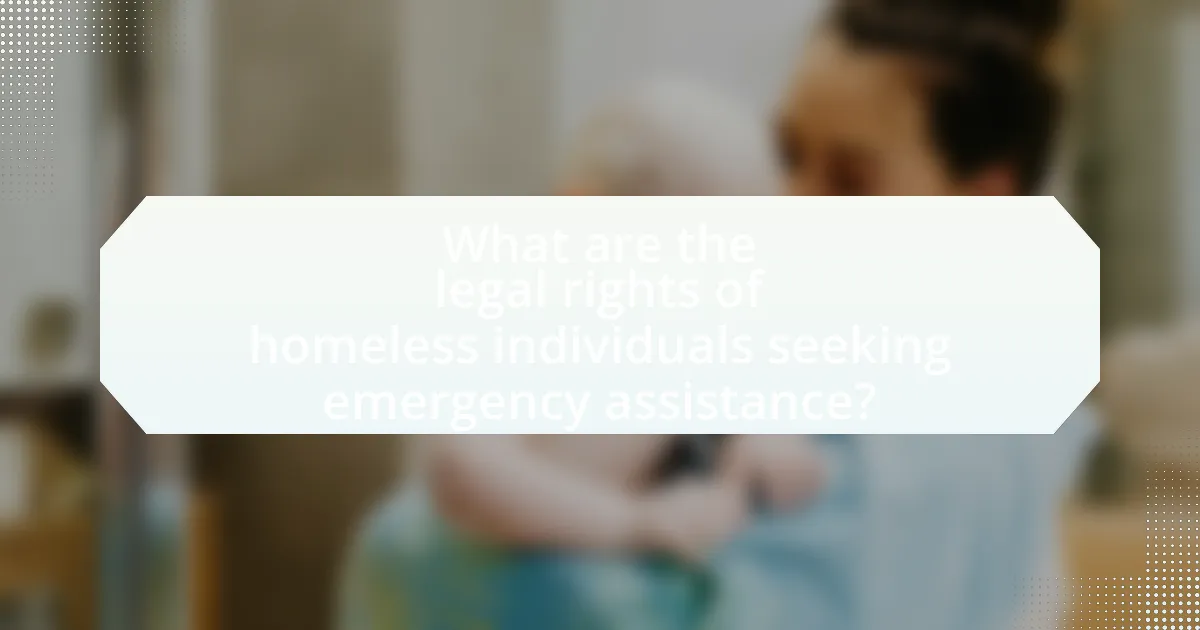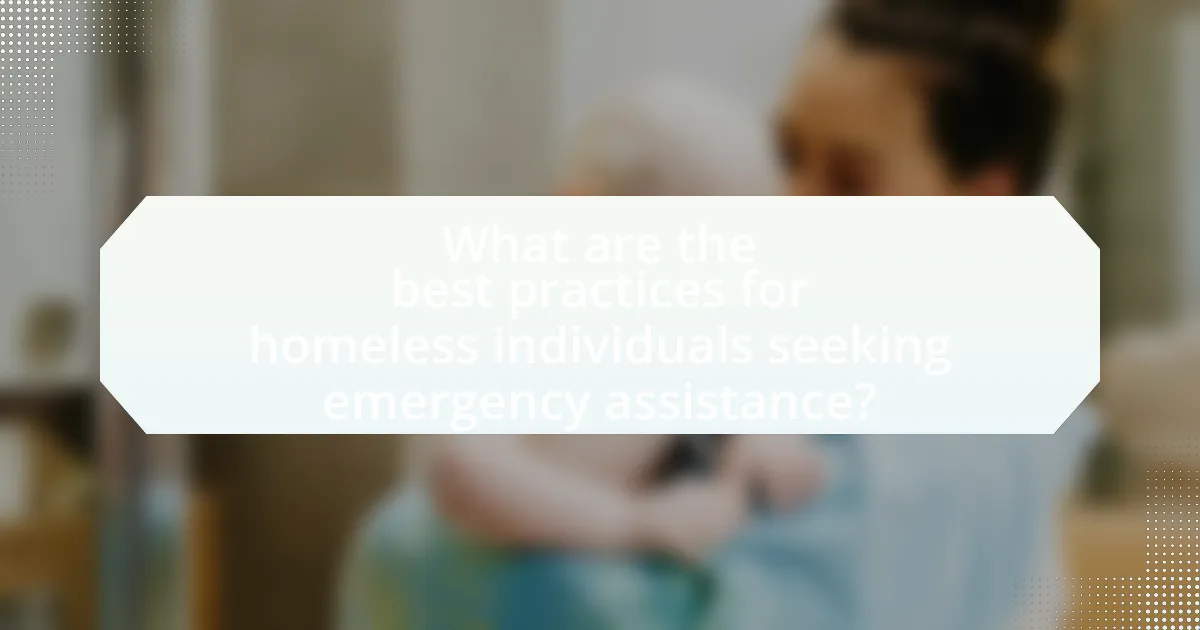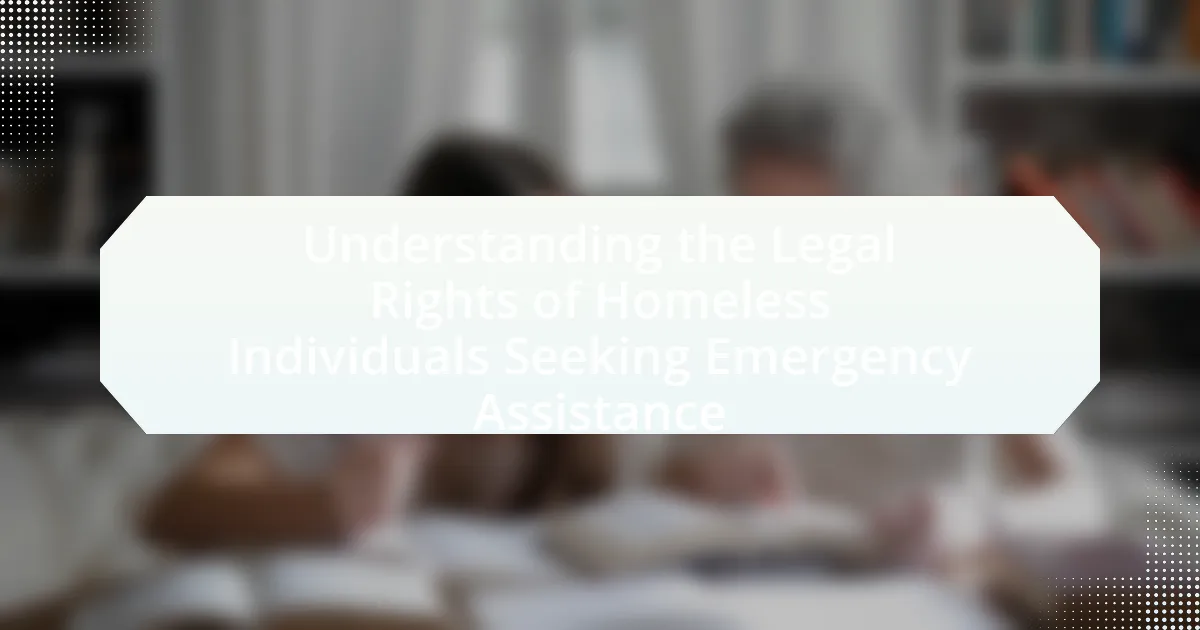The article focuses on the legal rights of homeless individuals seeking emergency assistance, highlighting their entitlement to shelters, food, and medical care under federal laws such as the Stewart B. McKinney Act. It examines how these rights vary by jurisdiction, influenced by local laws and resources, and discusses the role of federal legislation in protecting these rights. Additionally, the article outlines the types of emergency assistance available, eligibility criteria for accessing shelters, and the importance of understanding legal rights for advocacy. It also addresses the challenges faced by homeless individuals in asserting their rights and the support provided by community organizations and local governments in navigating these legal frameworks.

What are the legal rights of homeless individuals seeking emergency assistance?
Homeless individuals have the legal right to seek emergency assistance, which includes access to shelters, food, and medical care. The U.S. Department of Housing and Urban Development (HUD) mandates that local governments provide emergency shelter and services to those experiencing homelessness under the Stewart B. McKinney Act. This law requires that individuals be treated fairly and without discrimination based on race, gender, or disability when seeking assistance. Additionally, the right to emergency assistance is reinforced by various state laws and local ordinances that aim to protect the welfare of homeless individuals, ensuring they receive necessary support during crises.
How do these rights vary by jurisdiction?
The rights of homeless individuals seeking emergency assistance vary significantly by jurisdiction, influenced by local laws, policies, and available resources. For instance, some jurisdictions may have robust legal frameworks that guarantee access to emergency shelters and services, while others may impose restrictions based on factors such as residency or behavior. In the United States, the legal landscape is shaped by federal laws like the McKinney-Vento Homeless Assistance Act, which provides guidelines for assistance, but implementation and enforcement differ widely across states and municipalities. Additionally, court rulings, such as those from the Ninth Circuit Court of Appeals, have established precedents that affect how rights are interpreted, further contributing to the variability in access to emergency assistance for homeless individuals.
What federal laws protect the rights of homeless individuals?
The federal laws that protect the rights of homeless individuals include the Stewart B. McKinney Homeless Assistance Act, the Fair Housing Act, and the Americans with Disabilities Act. The Stewart B. McKinney Homeless Assistance Act, enacted in 1987, provides federal funding for homeless assistance programs and establishes a definition of homelessness, ensuring access to services. The Fair Housing Act prohibits discrimination in housing based on race, color, national origin, religion, sex, familial status, or disability, which extends protections to homeless individuals seeking housing. The Americans with Disabilities Act mandates that individuals with disabilities, including those experiencing homelessness, have equal access to public services and accommodations. These laws collectively aim to safeguard the rights and dignity of homeless individuals in the United States.
How do state laws differ in protecting these rights?
State laws vary significantly in their protection of the rights of homeless individuals seeking emergency assistance. For instance, some states have enacted comprehensive laws that explicitly guarantee access to emergency shelters and services, while others may lack such protections or have more restrictive criteria for eligibility. In California, the law mandates that local governments provide emergency shelter options, reflecting a commitment to addressing homelessness, whereas in states like Texas, the legal framework may prioritize law enforcement responses over social services, limiting access to necessary assistance. These differences can be attributed to varying state policies, funding levels, and political attitudes towards homelessness, which ultimately shape the legal landscape for homeless individuals seeking help.
What types of emergency assistance are available to homeless individuals?
Homeless individuals can access various types of emergency assistance, including emergency shelters, food assistance programs, medical care, and financial aid for housing. Emergency shelters provide immediate housing and safety, often with additional services like meals and counseling. Food assistance programs, such as food banks and soup kitchens, offer essential nutrition. Medical care is available through clinics that cater specifically to the homeless population, ensuring access to healthcare services. Financial aid programs, often administered by government agencies or non-profits, can assist with temporary housing costs or utility payments. These forms of assistance are crucial for addressing the immediate needs of homeless individuals and facilitating their transition to stable living conditions.
What are the eligibility criteria for accessing emergency shelters?
Eligibility criteria for accessing emergency shelters typically include being homeless or at imminent risk of homelessness, having no safe alternative housing, and meeting specific local requirements such as age, family status, or income limits. Many shelters prioritize individuals based on vulnerability factors, including mental health status, substance abuse issues, or domestic violence situations. Local laws and regulations often dictate these criteria, ensuring that shelters serve those most in need effectively.
How can homeless individuals access food assistance programs?
Homeless individuals can access food assistance programs by visiting local food banks, soup kitchens, and community centers that provide meals and groceries. Many cities have organizations that specifically cater to the needs of homeless populations, offering services without requiring proof of residency or income. For example, the U.S. Department of Agriculture’s Supplemental Nutrition Assistance Program (SNAP) allows eligible individuals to apply for food benefits, which can be done online or in person at designated offices. Additionally, the National Hunger Hotline (1-866-348-6479) can connect homeless individuals to local resources and food assistance programs.

Why is understanding these legal rights important for homeless individuals?
Understanding legal rights is crucial for homeless individuals because it empowers them to access essential services and protections. Knowledge of these rights enables homeless individuals to advocate for themselves, ensuring they receive necessary assistance such as shelter, healthcare, and legal representation. For instance, the U.S. Supreme Court case Martin v. City of Boise established that cities cannot criminalize sleeping in public spaces when there are insufficient shelter beds available, highlighting the importance of legal awareness in preventing unjust treatment. This understanding can lead to improved living conditions and a greater chance of securing stable housing.
How can knowledge of legal rights empower homeless individuals?
Knowledge of legal rights empowers homeless individuals by providing them with the information necessary to advocate for themselves and access essential services. When homeless individuals understand their rights, such as the right to emergency shelter, food assistance, and protection from discrimination, they can effectively navigate systems that may otherwise marginalize them. For instance, the U.S. Department of Housing and Urban Development outlines that individuals experiencing homelessness have the right to receive assistance without facing discrimination based on race, gender, or disability. This knowledge enables them to challenge unjust practices and seek legal recourse when their rights are violated, ultimately fostering a sense of agency and dignity in their pursuit of stability and support.
What role does advocacy play in protecting these rights?
Advocacy plays a crucial role in protecting the legal rights of homeless individuals seeking emergency assistance by raising awareness, influencing policy, and ensuring accountability. Through organized efforts, advocacy groups highlight the challenges faced by homeless individuals, which can lead to legislative changes that enhance their access to essential services. For instance, the National Law Center on Homelessness & Poverty has documented how advocacy efforts have resulted in improved access to shelters and emergency services in various jurisdictions. By mobilizing public support and engaging with lawmakers, advocacy not only empowers homeless individuals but also fosters systemic changes that uphold their rights.
How can legal aid organizations assist homeless individuals?
Legal aid organizations assist homeless individuals by providing access to legal representation and resources that help them navigate their rights and entitlements. These organizations can help secure benefits such as food assistance, healthcare, and housing support, which are crucial for individuals experiencing homelessness. For instance, legal aid can assist in challenging wrongful evictions or discrimination in housing, ensuring that homeless individuals are aware of their legal protections under laws like the Fair Housing Act. Additionally, studies show that legal representation can significantly improve outcomes for homeless individuals, such as increasing access to stable housing and reducing the duration of homelessness.
What challenges do homeless individuals face in asserting their rights?
Homeless individuals face significant challenges in asserting their rights, primarily due to systemic barriers, lack of access to resources, and social stigma. Systemic barriers include inadequate legal protections and policies that often overlook the needs of homeless populations, making it difficult for them to navigate the legal system. Additionally, many homeless individuals lack access to legal representation, which is crucial for effectively asserting their rights. A study by the National Law Center on Homelessness & Poverty highlights that only 10% of homeless individuals receive legal assistance, further complicating their ability to advocate for themselves. Social stigma also plays a critical role, as negative perceptions can lead to discrimination and a lack of support from both the public and service providers, hindering their efforts to claim their rights.
How does stigma affect access to emergency assistance?
Stigma significantly hinders access to emergency assistance for homeless individuals. This stigma often manifests as negative stereotypes and discrimination, leading to feelings of shame and reluctance to seek help. Research indicates that 60% of homeless individuals report avoiding shelters due to fear of judgment or mistreatment, which directly impacts their ability to access necessary services. Furthermore, stigma can result in systemic barriers, such as policies that prioritize certain populations over others, thereby limiting the availability of resources for those most in need.
What barriers exist in navigating the legal system for homeless individuals?
Homeless individuals face significant barriers in navigating the legal system, primarily due to lack of access to resources, legal knowledge, and stable identification. The absence of a permanent address complicates the ability to receive legal notifications and access court services, as many legal processes require a fixed location for communication. Additionally, many homeless individuals lack the financial means to hire legal representation, which is crucial for effectively navigating complex legal issues. Research indicates that approximately 40% of homeless individuals have experienced legal problems that could be addressed through legal aid, yet only a fraction receive assistance due to systemic barriers. Furthermore, the stigma associated with homelessness can lead to discrimination within the legal system, further hindering their ability to seek justice and assistance.

What are the best practices for homeless individuals seeking emergency assistance?
Homeless individuals seeking emergency assistance should first identify local shelters and services that provide immediate support. Research indicates that accessing resources such as food banks, emergency shelters, and social services can significantly improve their situation. For example, the U.S. Department of Housing and Urban Development (HUD) reports that emergency shelters are crucial for providing temporary housing and essential services to those in need. Additionally, individuals should gather necessary documentation, such as identification and any relevant medical records, to expedite the assistance process. Engaging with local outreach programs can also enhance access to resources, as these organizations often have established connections with service providers.
How can homeless individuals effectively communicate their needs?
Homeless individuals can effectively communicate their needs by clearly articulating their situation and specific requirements to service providers and the public. Utilizing direct language and being specific about their needs, such as requesting food, shelter, or medical assistance, increases the likelihood of receiving help. Research indicates that effective communication can lead to better access to resources; for instance, a study published in the Journal of Social Issues highlights that clear communication improves service delivery outcomes for homeless populations. Additionally, engaging with outreach programs that specialize in assisting homeless individuals can provide them with tools and support to express their needs more effectively.
What documentation is helpful when seeking assistance?
When seeking assistance, helpful documentation includes identification documents, proof of residency or homelessness, and any relevant medical records. Identification documents, such as a driver’s license or state ID, establish identity and eligibility for services. Proof of residency or homelessness, like a utility bill or a letter from a shelter, verifies the individual’s current living situation. Medical records can support claims for health-related assistance, demonstrating the need for specific services. These documents collectively enhance the chances of receiving timely and appropriate help.
How can individuals prepare for interactions with service providers?
Individuals can prepare for interactions with service providers by gathering necessary documentation and understanding their rights. This preparation includes collecting identification, proof of income, and any relevant medical records, which can facilitate the service provider’s assessment of their needs. Additionally, individuals should familiarize themselves with local laws and regulations regarding emergency assistance, as this knowledge empowers them to advocate for their rights effectively. Research indicates that being informed about legal rights significantly enhances the likelihood of receiving appropriate assistance, as individuals who understand their entitlements are better equipped to navigate the system and communicate their needs clearly.
What resources are available for ongoing support and advocacy?
Ongoing support and advocacy resources for homeless individuals seeking emergency assistance include legal aid organizations, community service agencies, and advocacy groups. Legal aid organizations, such as the Legal Services Corporation, provide free legal assistance to low-income individuals, helping them understand their rights and navigate the legal system. Community service agencies, like the Salvation Army and local shelters, offer essential services including food, housing assistance, and counseling. Advocacy groups, such as the National Alliance to End Homelessness, work to influence policy and raise awareness about the needs of homeless individuals, providing a platform for their voices. These resources collectively empower homeless individuals by ensuring they have access to necessary support and legal representation.
How can community organizations assist in navigating legal rights?
Community organizations assist individuals in navigating legal rights by providing resources, education, and advocacy tailored to specific legal issues. These organizations often offer workshops and informational sessions that clarify legal rights related to housing, public assistance, and emergency services, which are crucial for homeless individuals. For instance, organizations like the National Law Center on Homelessness & Poverty provide legal resources and support that empower individuals to understand their rights under laws such as the McKinney-Vento Homeless Assistance Act. Additionally, community organizations frequently connect individuals with legal aid services, ensuring access to professional legal representation when needed. This multifaceted approach enhances awareness and understanding of legal rights, ultimately aiding homeless individuals in effectively asserting those rights in emergency situations.
What role do local governments play in supporting homeless individuals?
Local governments play a crucial role in supporting homeless individuals by providing essential services such as emergency shelters, food assistance, and access to healthcare. These local entities often implement programs funded by federal and state resources, which aim to address immediate needs and facilitate long-term solutions for homelessness. For instance, the U.S. Department of Housing and Urban Development (HUD) reports that local governments utilize Continuum of Care programs to coordinate services and funding for homeless assistance, ensuring that individuals receive comprehensive support tailored to their circumstances.

Leave a Reply